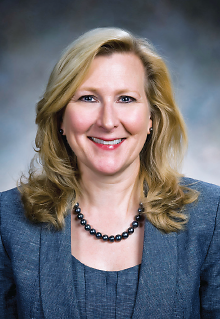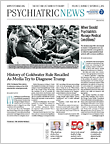The Milestones Project has come to medical school education.
Educators with the Association of Directors of Medical School Education in Psychiatry (ADMSEP) have developed a set of learning goals and milestones in psychiatry for medical students. They are aligned with the core competencies developed for residency programs by the Accreditation Council for Graduate Medical Education (ACGME) and structured, like the residency Milestones, in successive stages of advancing knowledge as students move through medical school.
Brenda Roman, M.D., chair of the ADMSEP Task Force that developed the initiative for medical school education, told Psychiatric News that the “Key Diagnoses, Learning Goals, and Milestones for Psychiatry in Undergraduate Medical Education”—its formal name—constitutes a set of competencies associated with caring for patients with psychiatric illness that all students should be able to demonstrate before graduating, regardless of the field of medicine in which they choose to specialize.
Unlike the residency Milestones, however, meeting the ADMSEP learning goals and milestones is voluntary, and they are designed to be flexible enough for adaptation to the culture of individual medical schools.
“They are meant to be broad enough so that individual schools can choose to include more specific objectives and readily incorporate them in the framework,” she said. “Directors of psychiatric education for medical students can use this document as a guideline, realizing that each school has unique circumstances, patient populations, and missions that need to be taken into consideration in determining what is best for an institution and its students.”
Roman is past president of ADMSEP and assistant dean of medical education at Wright State University Boonshoft School of Medicine in Dayton, Ohio.
The six competencies are medical knowledge, patient care (clinical skills), systems-based practice, interpersonal skills and communication, caring-valuing (professionalism), and practice-based learning.
For instance, under the “medical knowledge” competency, the ADMSEP learning objectives cover four specific skills: describe the normal psychological development across the lifespan, describe the psychobiological-behavioral theories for psychiatric disorders and substance use disorders, describe the psychopharmacological treatments and psychotherapies for psychiatric disorders, and demonstrate knowledge of psychiatric concepts, components of the psychiatric mental status exam, and cognitive screening.
Each of those skills is further broken down into more granular learning objectives for the preclinical and clinical stages of medical school.
“The learning goals and milestones should be regarded as a precursor to residency—what all general medical students should know about a topic in psychiatry so they are prepared to tackle residency Milestones,” said task force co-chair Dawnelle Schatte, M.D., in an interview with Psychiatric News. “It’s a consensus document of experts, not a requirement dictated from the top down.” She is director of undergraduate medical education at the University of Texas Medical Branch at Galveston.
Schatte also said the learning goals and milestones align with the Core Entrustable Professional Activities developed by the Association of American Medical Colleges. The latter are a formal outline of the activities and requisite competencies and behaviors that every graduating medical student should be able to perform without supervision at the start of residency (
Psychiatric News, July 25, 2014).
APA Director of Education Tristan Gorrindo, M.D., told Psychiatric News that the ADMSEP initiative is in line with a larger trend in medicine toward collaborative care.
“Only a small number of medical students will choose a career as a psychiatrist, but increasingly it is important that every medical student have foundational knowledge in treating patients with mental illness,” he said. “As the availability of models like collaborative care continues to grow, internists, pediatricians, and family practice physicians need basic competencies in mental health. These milestones help promote the development of baseline education at the medical school level to give students a solid foundation for additional training they may receive in residency. This project serves all of medicine, not just psychiatry.”
Additionally, Roman and colleagues have outlined a set of “key diagnoses.” These are the major psychiatric diagnoses that medical students should know by the time they graduate from medical school. Ideally, all students would have had clinical exposure or other intensive exposure through a learning experience to at least one of the diagnoses under each diagnostic category. Roman said they were selected because they are common or critical in the care of patients regardless of their age.
The diagnoses are grouped into 11 broad groups: neurodevelopmental disorders, schizophrenia spectrum and psychotic disorders, bipolar and related disorders, anxiety disorders, trauma and stressor-related disorders, eating and feeding disorders, somatic symptom and related disorders, substance-related and addictive disorders, cognitive disorders, personality disorders, and medication-induced movement disorders and other adverse effects of medication.
Roman said the “Key Diagnoses, Learning Goals, and Milestones” were built upon a similar document developed by ADMSEP educators more than a decade ago focused on clinical learning objectives. When the Milestones Project for residency was initiated, educators in pediatrics became the first specialty group to include the period of medical school. It was natural for psychiatric educators to do the same, drawing on the original learning objectives.
An 11-member task force, including Roman and Schatte, met for two years in person and via conference call. “Our collective expertise created a first draft that was further refined and edited by the members of the executive council of ADMSEP, then distributed to the membership for comments for a period of three months,” Roman said. Based on member comments, the task force refined it again and presented it to the Executive Council for approval a year ago.
Roman said she knows from the recent ADMSEP meeting that many medical school leaders are using the new resource as they undertake curriculum reform. More generally, schools can use the resource as a guide for complying with licensing requirements of the Liaison Committee on Medical Education.
“ADMSEP wanted to be the leaders in developing milestones for medical student education,” Roman said. “Many of us in medical education see this as the future.” ■
“Key Diagnoses, Learning Goals, and Milestones for Psychiatry in Undergraduate Medical Education” can be accessed
here.

